Valdelsa - Between Science and Economy
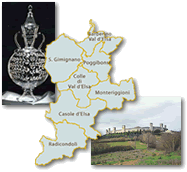
During the medieval epoch, the Val d’Elsa was the borderland between Siena and Florence, and this explains the presence on this territory of exceptional defensive structures like those of Monteriggioni and Colle di Val d’Elsa. When the demands for defence were no longer felt, the area witnessed the proliferation of specialised activities such as that of glass and crystal which, in more recent times, has been flanked by the exploitation of natural energy sources, such as geothermal energy.
Taking the Siena-Florence Motorway, the visitor can not but note the fascinating wall circuit of Monteriggioni, a famous example of medieval military architecture.
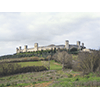
The impression aroused by the vision of the citadel at the time of its greatest splendour must have been great. In his Divine Comedy (Inferno, canto XXXI, vv. 40-45), Dante compares the giants placed between the 8th and 9th circle of Hell to its two tall towers.
«for as, on its round wall, Montereggione
is crowned with towers, so there towered here,
above the bank that runs around the pit,
with half their bulk, the terrifying giants,
whom Jove still menaces from Heaven when
he sends his bolts of thunder down upon them.»Founded by the Sienese between 1213 and 1219 as an outpost against the Florentines, in antiquity Monteriggioni was famed as an impregnable fortress; a fully merited fame considering that it fell only after the betrayal of a Florentine political exile in 1554. With a perimeter of 570 metres, the walls were interspersed with 15 quadrangular towers with battlements and bartizans (a type of wooden balcony that jutted out in the points of greatest defensive efforts), while externally, it was surrounded by a moat which was filled with coal and ignited in case of siege. Moreover, in correspondence to one of the two surviving entry gates, there appears to have been yet another defence structure, a rectangular-shaped ravelin (outpost). The entirety constitutes an excellent example of technical-military knowledge of the medieval period.
Passed down to our times almost intact (the towers were lowered in the 16th century to draw in line with the new firearms, though several were raised later), this splendid ancient village, every summer, evokes its glorious past. On the occasion of its medieval feast, all of the inhabitants don period costumes and interpret a specific character for several days. All signs of modernity, such as automobiles and electric energy, are banished, while legal tender is exchanged for "the Monteriggioni scudo", which makes it possible to savour the "ancient" flavours of the village’s typical products.
(Elena Fani)
Adapting the defensive structures to firearms is masterfully exemplified by the fifteenth-century Porta Volterrana gate of the nearby Colle di Val d’Elsa, a picturesque village located south of Poggibonsi and accessible via SR2 and SP5.
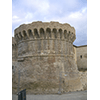
Stronghold on the western side of the walls of Upper Colle, the Volterrana Gate constitutes a point of reference in the history of the evolution of defensive systems of the Medici period. Built in 1479 with the contribution of expert military architects like Francione, Giuliano da Sangallo, Francesco d’Angelo and Paolo di Francesco, it indeed presents several elements which we find hereinafter in the construction of fortresses. Two powerful round brick keeps embrace the tract of wall where the round-arched gate is sited. The entire system is equipped with a high scarp and protruding defensive elements set on triangular stone corbels and brick arches, while the middle area is marked by two cordons (protruding stone structures born to prevent the walls being easily scaled; in the 16th century, with the introduction of bastions, they were regularly adopted). The whole lot is crowned by a parapet with battlements and embrasures (apertures for cannons).
(Elena Fani)
Also worth a visit in Colle is the Museo del Cristallo which, with glass exhibits and reconstructions, documents the centuries-old tradition of crystal making in the area.
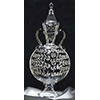
Founded in 2001, the Museum presents the history of crystal making in Colle di Val d’Elsa from the 19th century to the present. The largest section is dedicated to the glassmaking industry of Colle di Val d’Elsa from 1820, when the first furnace was built, to the manufacture of lead crystal in 1963. Also on show are glass exhibits from the 14th and 15th centuries which document the historical glassmaking activity in Valdelsa, in addition to objects carved with the age-old technique of the copper wheel. Quite noteworthy is the technological section where a traditional work environment - with the life-size cutaway reproduction of a furnace - stands alongside its modern automated counterpart. The Museum is housed in an underground space along with old glass and crystal shops.
(Stefania Mangia)
For visitors interested in the riches of the territory, we advise, finally, a visit to Radicondoli, a locality situated about 30 kilometres away following SP541 south, where a Museum, one of its kind in Italy, is dedicated to arousing awareness of the geothermal resources of the territory.
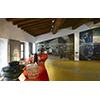
Inaugurated in February 2004 in a renovated old building, the small but very interesting museum interlinks with the territory’s typical resources, in particular the fumaroles and the energy sources that emanate from the earth. The "fumaroles and lagoni (mud volcanoes) of Siena territory" were studied in the late 18th century by famed scientist Paolo Mascagni who confirmed the presence of boric acid, which had been identified for the first time in the domed lagone of Monterotondo by chemist Uberto Francesco Hoefer, director of the grand-ducal pharmacies.
The exhibition of the Museum of Radicondoli follows an itinerary that is both historical-scientific and didactic: several period apparatuses illustrate themes and phenomena that the visitors themselves can generate, thanks to devices and functioning models. The rich photographic and explanatory apparatuses clarify even the most complex and difficult topics to the best advantage.
The museum also suggests the "energy itineraries" across landholdings and farms, mills and ironworks, olive presses and geothermal energy plants, such as the nearby "Le Pianacce" Plant.
(Mara Miniati)
****************************
Texts by Elena Fani
English translation by Victor Beard
Last update 05/feb/2008



 = libraries and archives
= libraries and archives  = scientific research centers
= scientific research centers  = memorial places of scientists
= memorial places of scientists = public health places
= public health places = places of science and worship
= places of science and worship = places of technology
= places of technology  = museums and collections
= museums and collections  = villas and gardens of science
= villas and gardens of science

